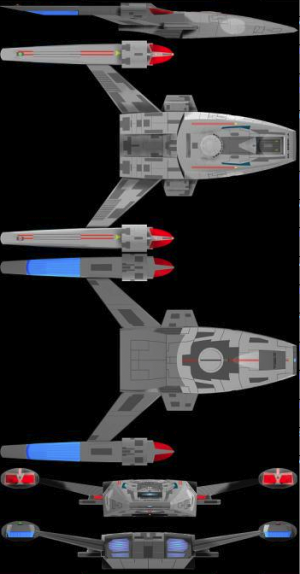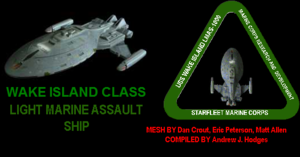Difference between revisions of "Wake Island Class Marine Strike Cruiser"
(No difference)
|
Revision as of 17:02, 7 August 2013
Class History
The Wake Island class was developed in the manner similar to previous vessel classes utilized in the Marine Assault Fleet, namely the Gibraltar Class, in that it was a refit and upgrade of a previously mothballed class.The lead designer was then-Colonel Mirax Terrik, acting Director of Marine Research and Development Command and the time.
In order to streamline the development process, but mainly to cut costs, the MSC began with the hull of the Dominion War era veteran Yeager Class (retired). The computer core was then upgraded to enable the significant increase to the amount of systems to be automated. Structural improvements were applied to enable a more stable warp field and impulse velocity, topped with a more powerful warp core. The increase in warp power output enabled stronger shields and the addition of ablative armor. Phaser alignment was completely readjusted, as were torpedo tube placements. Lastly, the vessel was configured for troop carrying and deployments, to include small dropship capabilities. The complete product was designed for a new mission profile akin to a blockade runner of sorts. Her primary role was to deploy troops covertly or during low intensity conflicts. However, with her increase firepower and durability in terms of defensive power, the class was also capable of providing fire support to operations where needed. Because of the combination of speed and power of the new MSC, she quickly became a favorite for SFMC Recon and SFSOCOM missions, with several being ordered by SFSOCOM for exclusive use and additional refitting.
The class gets its name from an historical battle involving Earth's United States Marine Corps during the Second World War. The Battle of Wake Island featured a drastically outnumbered defending Marine force, facing two consecutive Imperial Japanese Invasion forces. While their defeat was inevitable and eventual, the Marines on Wake Island held out against insurmountable odds, and defeated well over ten times their number in men and equipment before being forced to surrender.
Specifications
| Type: | Marine Strike Cruiser (MSC) |
| Size | |
|---|---|
| Length: | 328.9 Meters |
| Width: | 150 Meters |
| Height: | 85.52 Meters (11 Decks) |
| Weight: | 550,000 Metric Tons |
| Crew | |
| Standard: | 15 Officers, 75 Enlisted, 1 Marine Company as standard (additional depending on mission) |
| Emergency: | 400 |
| Warp Engines | |
| Type: | 2 Main Warp Nacelles (Type 7C) |
| Cruise Speed: | 7.0 |
| Sustainable Speed: | 9.6 |
| Emergency Speed: | 9.8 (12 hour automatic shutdown) |
| Impulse Engines | |
| Type: | 2 Main Impulse Engines (Type 6) |
| Max Impulse: | .93 C |
| Defensive Systems | |
| Type: | Type 2 Main Shield Generator (MSG-2) |
| Other: | Ablative Armor Plating |
| Offensive Systems | |
| Phasers: | 1 bank of 2 Type G (1F-360D), 1 bank of 1 type G (1A-360D), 2 banks of 1 Type 1 (P/S) |
| Torpedoes: | 3 Quantum Photon Torpedo Launchers (2F/1A) |
| Other: | Planet Landing Capabilities (Blue Alert) |
| Computer Systems | |
| Type: | Daystrom Industries HSCS-2 (ships' systems heavily computerized) |
| Tractor/Repulsor | |
| Type: | 1 Main Tractor/Repulsor Beam, 3 Docking Tractors, 2 Shuttle Tractors. |
| Shuttles | |
| Type: | Any 3 of the following: Shuttlecraft - Type 9, Marine Combat Dropship, Marine Assault Dropship |
| Fighters | |
| Type: | None |
| Sensors | |
| Type: | Andorian Industries FSMSA-2 |
| Combat Ratings | |
| Offensive: | 50% |
| Defensive: | 70% |
| Maneuvering: | 80% |
| CER: | 66.6% |
Vessels
| Name | Registry | Launched |
|---|---|---|
| USS Wake Island | MSC-1000 | |
| USS Guadalcanal | MSC-1001 | |
| USS Iwo Jima | MSC-1002 |
- Designed by Paul Braggins.

